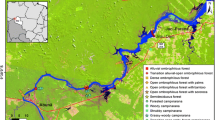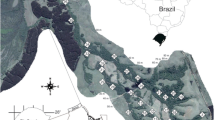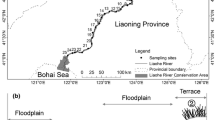Abstract
Classification of riverbed geomorphic surfaces based on flooding frequency was conducted and the relationship between their distribution and river morphology was analyzed, to provide an understanding of the structure and species composition of riparian forests dominated by Chosenia arbutifolia. The channel floors of two contrasting river morphologies (bar-braided and incised meandering channels), were divided into five geomorphic surfaces (gravel bar, lower and upper floodplains, secondary channel, and terrace) based on the water level of a 2-yr and a 20-yr recurrence interval. The environmental variables of the same geomorphic surfaces showed similar trends regardless of braided and meandering channel morphology, but differed significantly among the five geomorphic surfaces, which influenced the dominance of tree species. The geomorphic surface map based on recurrence interval of flood and physiognomical vegetation map based on aerial photos appeared almost identical. Geomorphic surface distribution, determined by river channel dynamics and the sediment transport processes occurring at a larger scale and a longer time frame, played an important role in shaping the structure and composition of the riparian forests. C. arbutifolia dominated gravel bar, and the upper and lower floodplains, because these geomorphic surfaces were characterized by gravelly soils which have lower soil moisture availability than soils of other geomorphic surfaces. Thus, an extensive distribution of C. arbutifolia in the braided channel section can be attributed to the frequent lateral migrations of river channels, which resulted in a high ratio of gravel bars, and lower and upper floodplains. In order to preserve indigenous plant communities in riparian zone, dynamic nature and processes of braided rivers should be maintained.
Similar content being viewed by others
References
D.E. Adams R.C. Anderson (1980) ArticleTitleSpecies response to a moisture gradient in central Illinois forests Am. J. Bot. 67 381–392
M. Aruga F. Nakamura S. Kikuchi T. Yajima (1996) ArticleTitleCharacteristics of floodplain forests and their site conditions in comparison to toeslope forests in the Tokachi River J. Jpn. Forestry Soc. 78 IssueID4 354–362
D.T. Bell (1980) ArticleTitleGradient trends in the streamside forest of central Illinois B. Torrey Bot. Club 107 172–180
D.T. Bell R. del Moral (1977) ArticleTitleVegetation gradients in the streamside forest of Hickory Creek, Will Country, Illinois B. Torrey Bot. Club 104 127–135
J. Bendix (1994) ArticleTitleScaledirection, and pattern in riparian vegetation-environment relationships Ann. Assoc. Am. Geogr. 84 IssueID4 652–665 Occurrence Handle10.1111/j.1467-8306.1994.tb01881.x
D.S. Dominick M.P. O’Neill (1998) ArticleTitleEffects of flow augmentation on stream channel morphology and riparian vegetation: upper Arkansas River Basin, Colorado Wetlands 18 IssueID4 591–607
D.J. Gilvear J. Cecil H. Parsons (2000) ArticleTitleChannel change and vegetation diversity on a low-angle alluvial fan, River Feshie Scotland Aquatic conserv. Marine Freshwater Ecosyst. 10 53–71 Occurrence Handle10.1002/(SICI)1099-0755(200001/02)10:1<53::AID-AQC348>3.0.CO;2-4
S.V. Gregory F.J. Swanson W.A. McKee K.W. Cummins (1991) ArticleTitleAn ecosystem perspective of riparian zones BioScience 41 540–551
S. Higashi (1964) ArticleTitleUse of willows in artificial revegetation for erosion control Res. B. Hokkaido Univ. Forest 23 151–228
K. Hirakawa Y. Ono (1974) ArticleTitleThe landform evolution of the Tokachi Plain Geogr. Rev. Jpn. 47 IssueID10 607–632
C.R. Hupp W.R. Osterkamp (1985) ArticleTitleBottom land vegetation distribution along Passage Greek, Virginiain relation to fluvial landforms Ecology 66 IssueID3 670–681
S. Ishikawa (1987) ArticleTitleEcological studies on the willow communities on the Satunai River floodplain, Hokkaidowith special reference to the development of the Chosenia arbutifolia forest Memoirs of the Faculty of Science Kochi University Series D. Biology 8 57–67
S. Ishikawa (1988) ArticleTitleFloodplain vegetation of the Ibi River in central Japan. Distribution behavior and habitat conditions of the main species of the river bed vegetation developing on the alluvial fan Jpn. J. Ecol. 38 IssueID2 73–84
S. Ishikawa (1994) ArticleTitleSeedling growth traits of three salicaceous species under different conditions of soil and water level Ecol. Rev. 23 IssueID1 1–6
Ishikawa S. and Asahina M. 1997. Seedling growth traits of salicaceous species which developed on the gravel bar in the Azusa RiverKamikochi. Research about the Dynamics of Riparian Communities in The Azusa River Kamikochi. Vol. 32–36 (in Japanese).
W.C. Johnson R.L. Burgess W.R. Keammerer (1976) ArticleTitleForest overstory vegetation and environment on the Missouri River floodplain in North Dakota Ecol. Monogr. 46 59–84
W.C. Johnson (1997) ArticleTitleEquilibrium response of riparian vegetation to flow regulation in the Platte River Nebraska Regul. River Res. Manage. 13 403–415 Occurrence Handle10.1002/(SICI)1099-1646(199709/10)13:5<403::AID-RRR465>3.3.CO;2-L
S. Karrenberg P.J. Edwards J. Kollmann (2002) ArticleTitleThe life history of Salicaceae living in the active zone of floodplains Freshwater Biol. 47 733–748 Occurrence Handle10.1046/j.1365-2427.2002.00894.x
S. Kawamura K. Ozawa (1970) ArticleTitleSampling method and gradation of the river bed material in the mountain region rivers J. Soc. Civil Eng. 55 IssueID12 53–58
T. Kikuchi O. Miura (1993) ArticleTitleVegetation patterns in relation to micro-scale landforms in hilly land regions Vegetatio 106 147–154
H. Kon S. Okitsu (1999) ArticleTitleRole of land-surface disturbance in regeneration of Ulmus davidiana var japonica in a cool temperate deciduous forest on Mt. Asamacentral Japan J. Jpn. Forest Soc. 81 29–35
L.B. Leopold G.M. Wolman (1957) ArticleTitleRiver channel patterns: Braided Meandering and Straight Geol. Surv. Prof. Paper 282 IssueIDB 39–85
Malanson G.P.1993.Riparian landscapes.Gambridge Studies in Ecology.Cambridge University Press,296 pp.
G.P. Malanson J. Kay (1980) ArticleTitleFlood frequency and the assemblage of dispersal types in hanging gardens of the narrows, Zion National Park, Utah Great Basin Naturalist 40 IssueID4 365–371
D.M. Merritt D.J. Cooper (2000) ArticleTitleRiparian vegetation and channel change in response to river regulation: a comparative study of regulated and unregulated streams in the Green River Basin, USA Regul. Rivers Res. Manage. 16 543–564 Occurrence Handle10.1002/1099-1646(200011/12)16:6<543::AID-RRR590>3.0.CO;2-N
D. Nagamatsu O. Miura (1997) ArticleTitleSoil disturbance regime in relation to micro-scale landforms and its effects on vegetation structure in a hilly area in Japan Plant Ecol. 133 191–200 Occurrence Handle10.1023/A:1009743932202
Y. Nagasaka (1996) ArticleTitleSalicaceae species inhabit at riparian zones Koshunai-Kihou 101 12–17
F. Nakamura (1986) ArticleTitleAnalysis of storage and transport processes based on age distribution of sediment Trans. Jpn. Geomorphol. Union 7 IssueID3 165–184
F. Nakamura N. Shin (2001) ArticleTitleThe downstream effects of dams on the regeneration of riparian tree species in northern Japan American Geophysical Union Monograph on “Geomorphic Processes and Riverine Habitat” Water Science and Application 4 173–181
F. Nakamura T. Yajima S. Kikuchi (1997) ArticleTitleStructure and composition of riparian forests with special reference to geomorphic site conditions along the Tokachi River northern Japan Plant Ecol. 133 209–219 Occurrence Handle10.1023/A:1009787614455
F. Nakamura F.J. Swanson (1994) ArticleTitleDistribution of coarse woody debris in a mountain stream. western Cascade RangeOregon Can. J. Forest Res. 24 2395–2403
G.C. Nanson H.F. Beach (1977) ArticleTitleForest succession and sedimentation on a meandering-river floodplain, northeast British Columbia Canada J. Biogeogr. 4 229–251
J. Neter W. Wasserman M.H. Kutner (1990) Applied linear statistical models: regression, analysis of varianceand experimental designs. 3rd edn Irwin, Homewood Illinois
K. Niiyama (1987) ArticleTitleDistribution of Salicaceae species and soil texture of habitats along the Ishikari River Jpn. J. Ecol. 37 IssueID3 163–174
K. Niiyama (1989) ArticleTitleDistribution of Chosenia arbutifolia and soil texture of habitats along the Satsunai River Jpn. J. Ecol. 39 IssueID3 173–182
K. Niiyama (1990) ArticleTitleThe role of seed dispersal and seedling traits in colonization and coexistence of Salix spp. in a seasonally flooded habitat Ecol. Res. 5 317–332
K. Niiyama (1995) ArticleTitleLife history traits of salicaceous species and riparian environment Jpn. J. Ecol. 45 IssueID3 301–306
J. Ohwi M. Kitagawa (1983) New flora of Japan Shibundo Co., Ltd. Tokyo
W.R. Osterkamp C.R. Hupp (1984) ArticleTitleGeomorphic and vegetative characteristics along three northern Virginia streams Geol. Soc. Am. B. 95 1093–1101 Occurrence Handle10.1130/0016-7606(1984)95<1093:GAVCAT>2.0.CO;2
K. Seiwa (1997) ArticleTitleVariable regeneration behaviour of Ulmusdavidiana var. japonica in response to disturbance regime for risk spreading Seed Sci. Res. 7 195–207
N. Shin S. Ishikawa S. Iwata (1999) ArticleTitleThe mosaic structure of riparian forest and its formation pattern along the Azusa River Kamikochi central Japan Jpn. J. Ecol. 49 71–81
J.R. Strykstra R.M. Bekker J. Van Andel (2002) ArticleTitleDispersal and life span spectra in plant communities: a key to safe site dynamics, species coexistence and conservation Ecography 25 145–160 Occurrence Handle10.1034/j.1600-0587.2002.250203.x
SYSTAT Inc. 1992. SYSTAT: statistics version 5.2 edition. SYSTAT Inc., Evanston, Ill.
M. Takagi F. Nakamura (2003) ArticleTitleThe downstream effects of water regulation by the dam on the riparian tree species in the Satsunai River J. Jpn. Forest Soc. 85 IssueID3 214–221
C.J.F. ter Braak (1987) ArticleTitleThe analysis of vegetation environment relationships by canonical correspondence analysis Vegetatio 69 69–77 Occurrence Handle10.1007/BF00038688
A.L. van Coller K.H. Rogers G.L. Heritage (2000) ArticleTitleRiparian vegetation-environment relationships: complimentarity of gradients versus patch hierarchy approaches J. Veg. Sci. 11 337–350
J.V. Ward K. Tockner D.B. Arscott C. Claret (2002) ArticleTitleRiverine landscape diversity Freshwater Biol. 47 517–539 Occurrence Handle10.1046/j.1365-2427.2002.00893.x
Author information
Authors and Affiliations
Corresponding author
Rights and permissions
About this article
Cite this article
Shin, N., Nakamura, F. Effects of fluvial geomorphology on riparian tree species in Rekifune River, northern Japan. Plant Ecol 178, 15–28 (2005). https://doi.org/10.1007/s11258-004-2484-9
Received:
Accepted:
Issue Date:
DOI: https://doi.org/10.1007/s11258-004-2484-9




